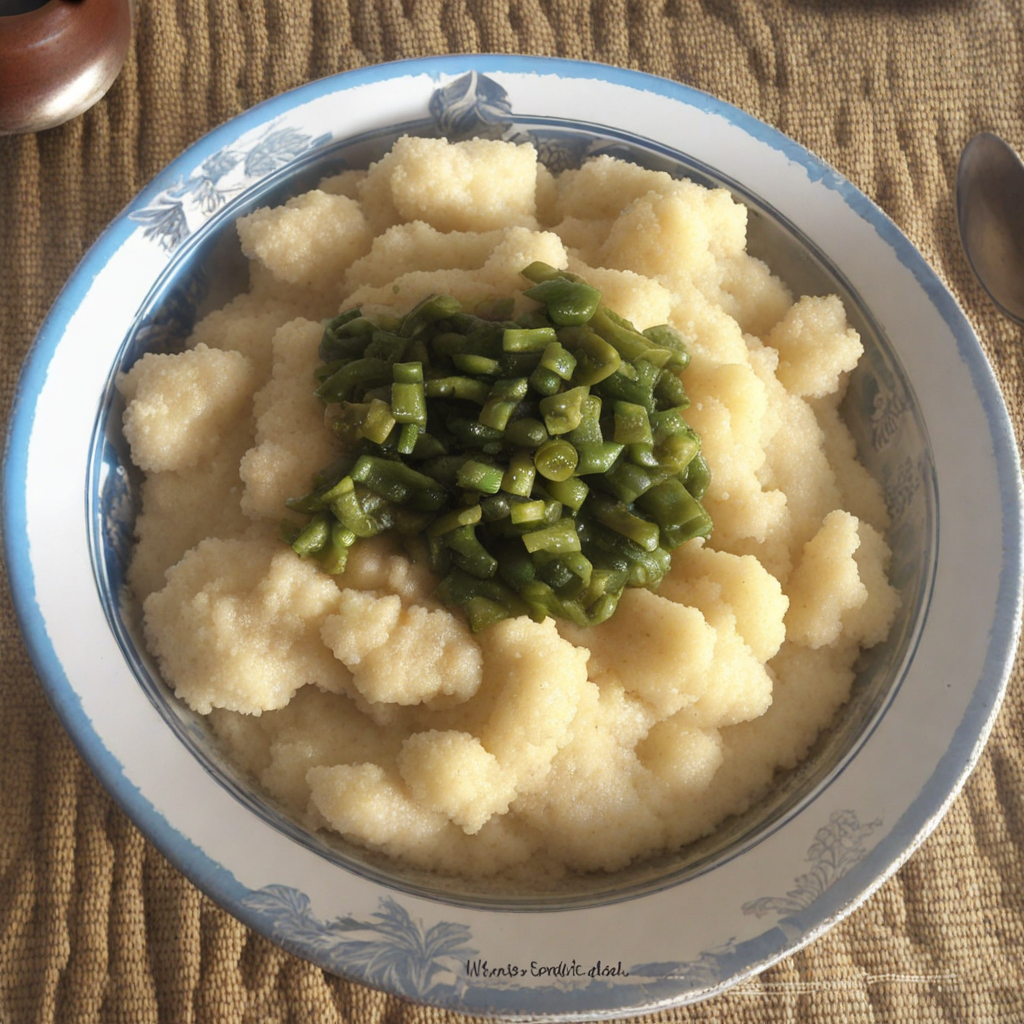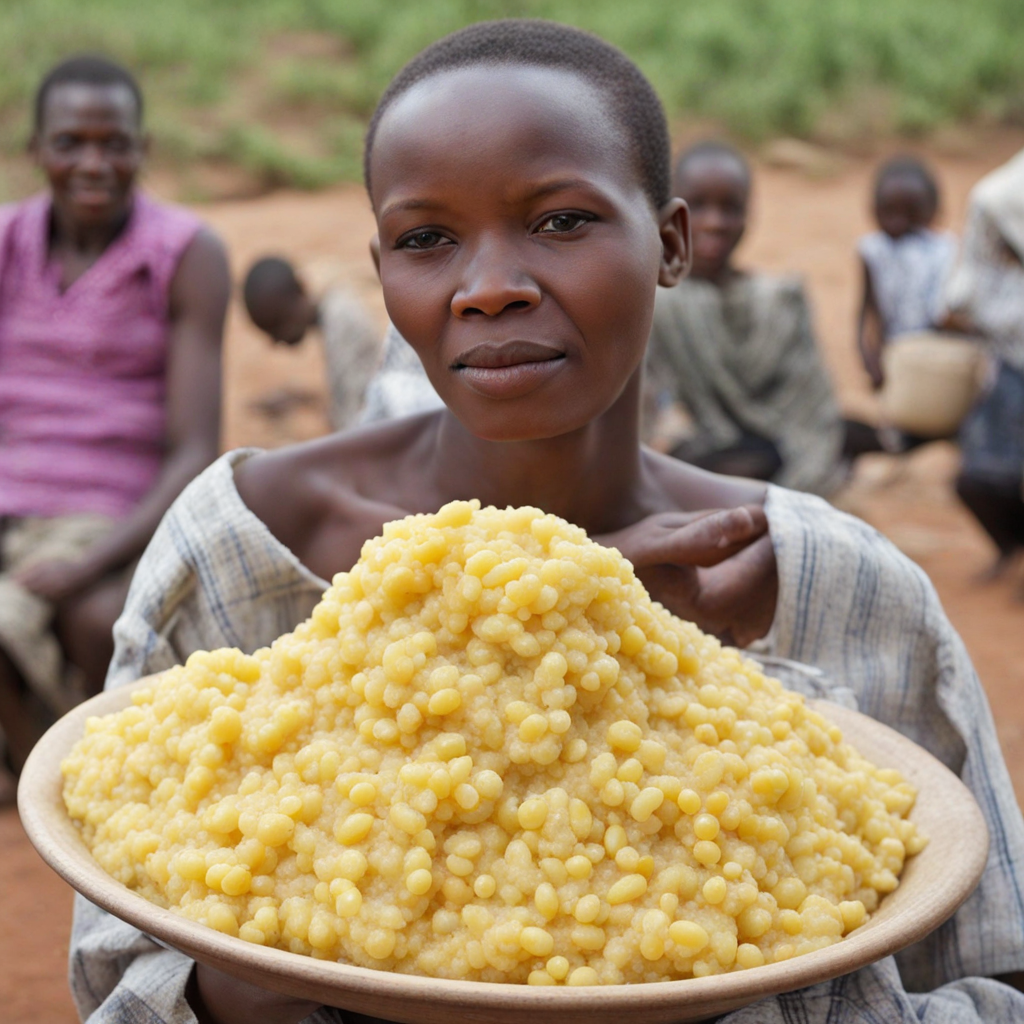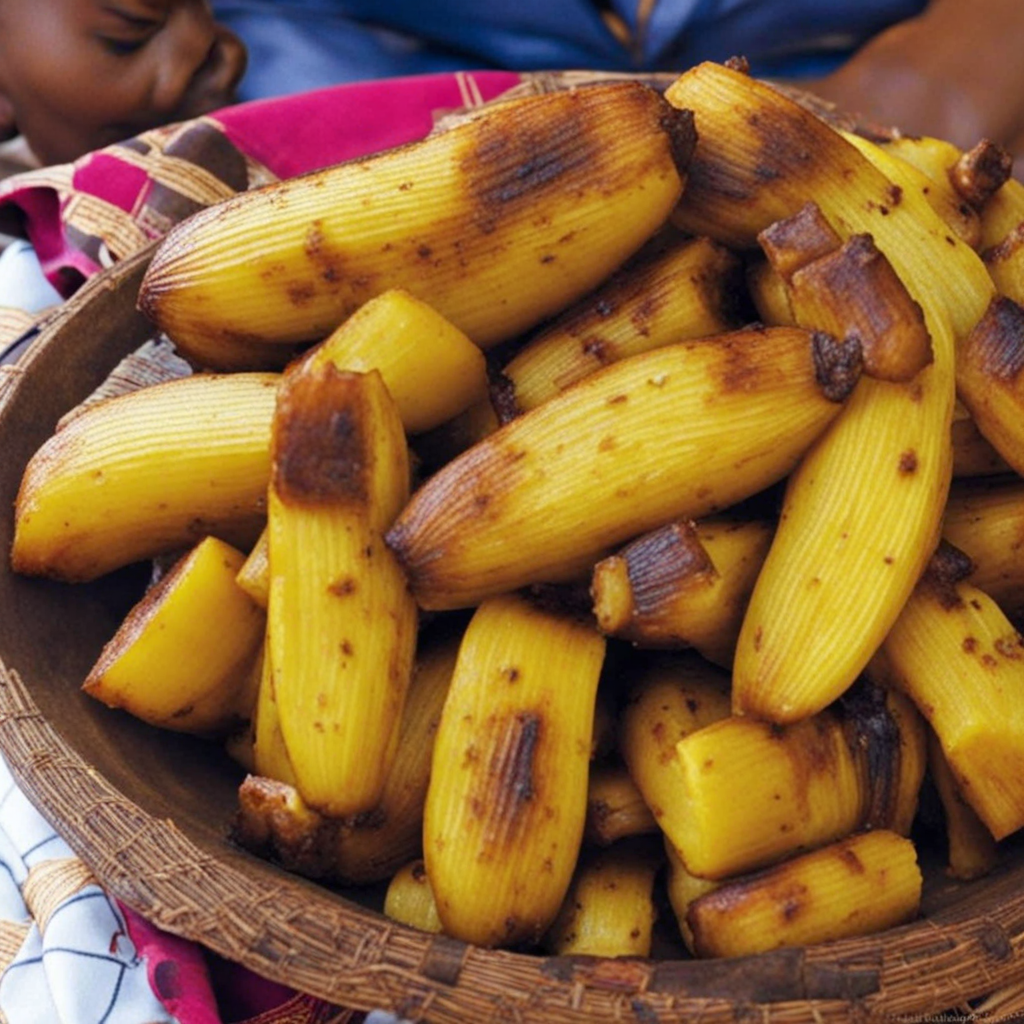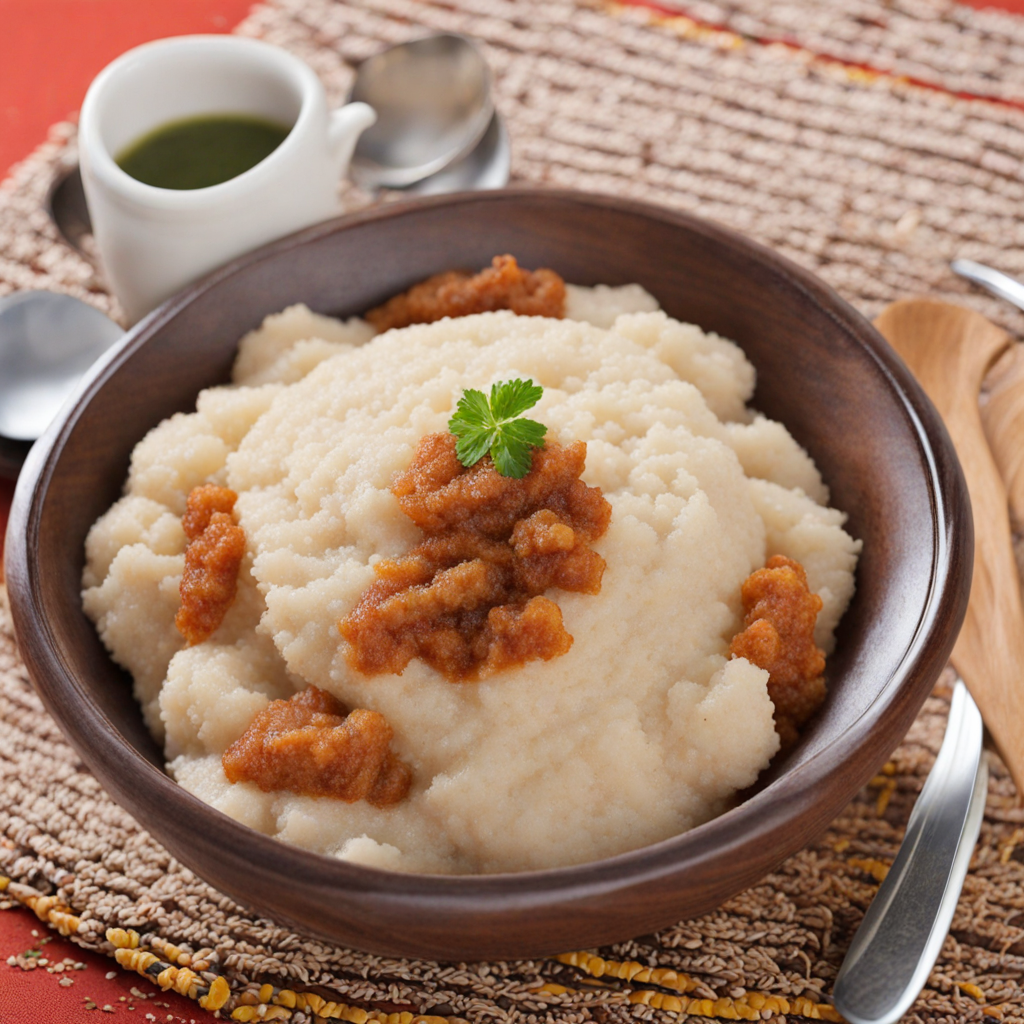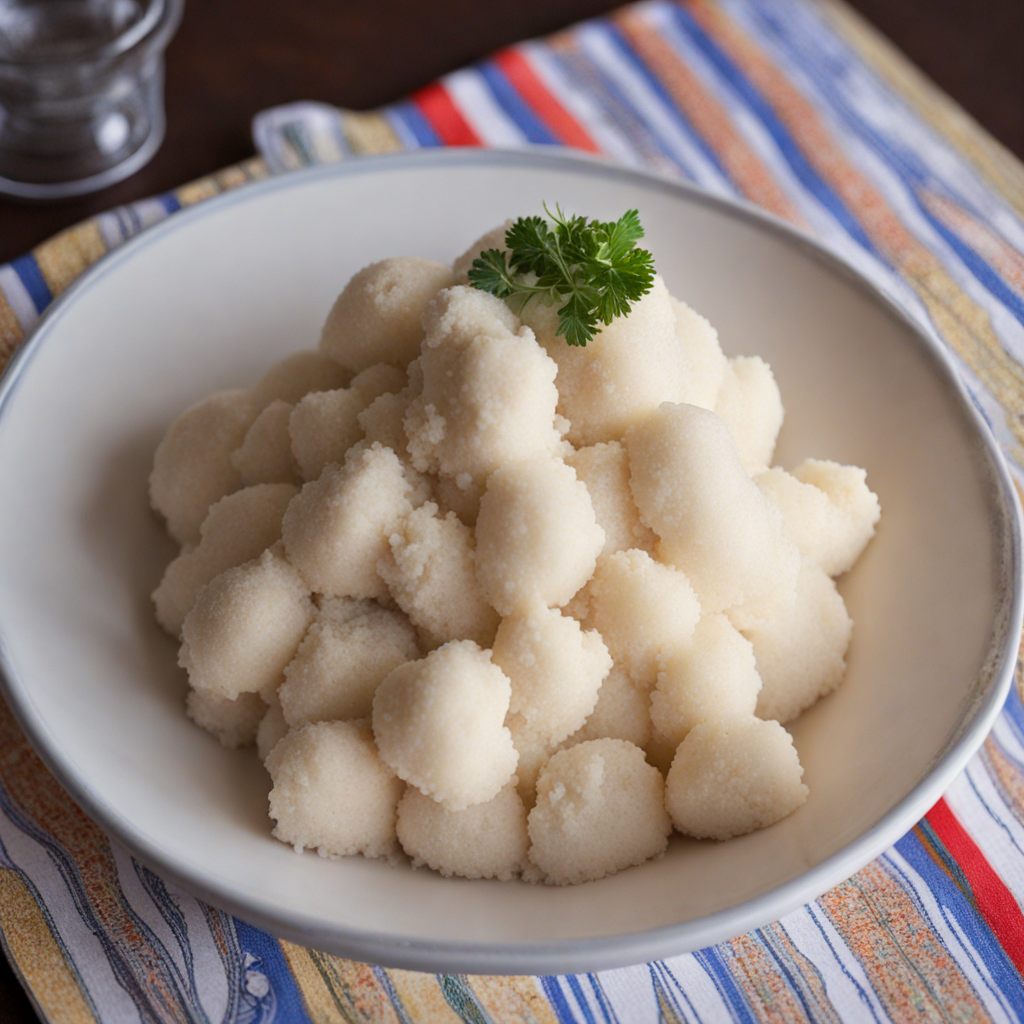Kawunga
Kawunga, a beloved staple in Rwandan cuisine, is a delightful dish made from fermented cassava flour, which gives it a unique tangy flavor and a slightly chewy texture. Often prepared as a thick porridge, Kawunga is traditionally served with a variety of savory accompaniments, from rich stews to grilled meats, allowing it to absorb the flavors of the dishes it accompanies. The process of fermentation not only enhances its taste but also contributes to its nutritional profile, making it a wholesome choice for those looking to explore the flavors of East Africa. The preparation of Kawunga is an art in itself, involving the careful mixing of cassava flour with water to achieve the desired consistency. As it cooks, the mixture transforms into a smooth, elastic mass that can be molded into shapes or served directly from the pot. This versatility allows Kawunga to be enjoyed in various forms, whether as a side dish or a main component of a meal. Its ability to pair with both spicy and mild dishes makes it an excellent canvas for experiencing the vibrant flavors of Rwandan spices and herbs. When tasting Kawunga, one can expect a comforting sensation that warms the palate. The subtle tang from fermentation offers a depth that contrasts beautifully with the richness of accompanying sauces. Whether enjoyed at a local eatery or prepared at home, Kawunga invites food lovers to engage with Rwandan culture through its unique taste and traditional significance, making it a must-try for anyone seeking a new culinary adventure.
How It Became This Dish
The History of Kawunga: A Staple Food of Rwanda Kawunga, a traditional Rwandan dish, is more than just a meal; it is a cultural emblem that encapsulates the essence of Rwandan culinary heritage. This simple yet nourishing food, made primarily from fermented cassava flour, has roots that trace back to the pre-colonial era in central Africa, intertwining with the historical, social, and agricultural tapestry of Rwanda. #### Origins: A Foundation in Agriculture The origins of kawunga can be traced to the agricultural practices of the early Rwandan communities. Cassava, a drought-resistant tuber, became a prominent crop in the Rwandan highlands due to its adaptability to varying soil conditions and climate. This crop was not only a reliable food source but also a symbol of resilience among the Rwandan people, especially during periods of famine. The process of making kawunga begins with the careful selection of cassava roots, which are peeled, washed, and then dried. The drying process is crucial as it allows for the fermentation that gives kawunga its unique flavor and texture. The dried cassava is ground into a fine flour, which is then mixed with water to create a thick porridge-like dish. This preparation method showcases the ingenuity of Rwandan cooks, who have historically relied on local ingredients and traditional techniques. #### Cultural Significance Kawunga is more than just sustenance; it is steeped in cultural significance. Traditionally, it has served as a communal food, often prepared in large quantities to feed extended families and groups during communal gatherings. The act of preparing kawunga is often a social event, bringing people together to share in the labor and joy of creating food. It embodies the spirit of cooperation and community, which is a cornerstone of Rwandan society. In Rwandan culture, food plays a vital role in social and ceremonial contexts. Kawunga has been served at various communal events, including weddings, festivals, and religious ceremonies. Its presence at these gatherings signifies abundance and hospitality, reinforcing social bonds. Furthermore, it is often accompanied by other traditional dishes, such as vegetables, beans, or meat, creating a well-rounded meal that emphasizes the importance of sharing and togetherness. #### Development Over Time As Rwanda evolved through the centuries, so too did the culinary landscape. The colonial period brought about significant changes in agricultural practices and food availability. During this time, cassava became a staple crop introduced by Portuguese traders in the 16th century. It quickly adapted to the local environment and became a crucial part of the Rwandan diet. The introduction of new agricultural techniques and the promotion of monoculture, primarily driven by colonial interests, impacted traditional farming methods. Despite these changes, the Rwandan people maintained their traditional dishes, including kawunga, which remained a staple food. The adaptability of kawunga allowed it to persist even in the face of modern agricultural practices. In the post-colonial era, Rwanda experienced significant social upheaval, particularly during the genocide in 1994. The impacts of this tragic event reverberated through all aspects of Rwandan life, including food practices. Many communities were displaced, and traditional food systems suffered. However, in the years following the genocide, there has been a resurgence of interest in traditional foods, and kawunga has emerged as a symbol of resilience and national identity. #### Modern Relevance Today, kawunga is experiencing a renaissance in Rwanda as the nation strives to reclaim its cultural heritage. Efforts are being made to promote local foods and traditional cooking methods, especially in the face of globalization and the increasing influence of Western diets. Kawunga is often served in Rwandan homes, restaurants, and at cultural events, reminding people of their roots and the importance of preserving culinary traditions. Moreover, the Rwandan government and various NGOs have recognized the nutritional value of cassava and its potential to combat food insecurity. As a versatile and nutritious staple, kawunga has become part of initiatives aimed at promoting local agriculture and improving food security. By advocating for the use of indigenous crops like cassava, these efforts not only support local farmers but also encourage the consumption of traditional foods. Kawunga has also found its way into the culinary scene beyond Rwanda's borders, as Rwandan diaspora communities promote their heritage through food. Restaurants and food festivals around the world are beginning to highlight traditional Rwandan dishes, including kawunga, allowing a broader audience to appreciate its flavors and cultural significance. #### Conclusion The history of kawunga is a testament to the resilience and adaptability of the Rwandan people. It has evolved from a simple agricultural product to a cherished cultural symbol, reflecting the social fabric of the nation. As Rwanda continues to navigate the complexities of a modern world, kawunga stands as a reminder of the importance of food in shaping identity and community. Through its preparation and consumption, kawunga invites us to explore the deep-rooted connections between food and culture, emphasizing the significance of tradition in a rapidly changing society. As we celebrate this traditional dish, we also honor the generations of Rwandans who have cultivated the land, nurtured their communities, and preserved their culinary heritage. In every bite of kawunga, there lies a rich history that speaks of survival, community, and the enduring power of food.
You may like
Discover local flavors from Rwanda


